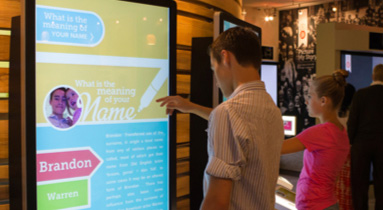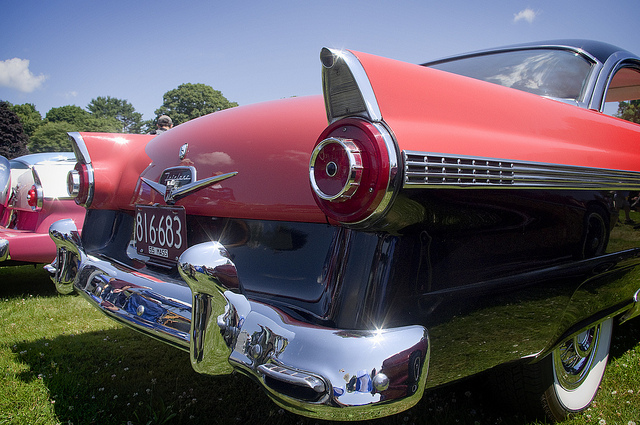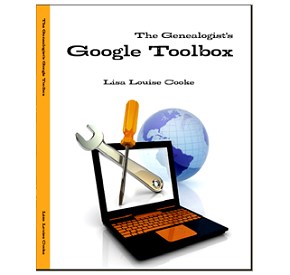by Lisa Cooke | Feb 12, 2015 | 01 What's New, FamilySearch, Kids, Libraries, Memory Lane, Mobile, Oral History, Photographs, RootsTech, Technology
 Wouldn’t it be great if you could bring your loved ones to a state-of-the art, museum-quality interactive exhibit that introduces them to their own family history?
Wouldn’t it be great if you could bring your loved ones to a state-of-the art, museum-quality interactive exhibit that introduces them to their own family history?
Now you can! A “prototype” FamilySearch Discovery Center was unveiled yesterday in downtown Salt Lake City in conjunction with RootsTech 2015. Visitors are handed a tablet computer and sent around to seven stations. At each they dock their tablet, which has their FamilySearch login programmed, and experience different aspects of history with their own family history data.
You can see your family’s international migration through the generations; superimpose yourself in historical costumes from several nations; check out the history and popularity of your first and last names; and enter a “time machine” with 3D historical re-creations of ancestral kitchens throughout the years. One of my favorite stations was one I almost skipped: the personal history interview in a private booth. You choose your life season, from child to senior, and a virtual interviewer appears on the screen and asks you a series of questions, which are recorded. All the data is later buy medication canada sent to you through your FamilySearch/email accounts.
For now you can only experience this in Salt Lake City. But this exhibit is meant to be replicated in major venues, and indeed has been booked for at least two so far in Seattle and Philadelphia, says FamilySearch CEO Dennis Brimhall. He chatted with me as I toured and confirmed that they are experimenting with this exhibit in different sizes and scales. He hopes to see versions of the FamilySearch Discovery Center one day in museums, libraries, archives, and heritage centers around the world. “We haven’t done a really good job of bridging the general public into family history,” he admitted. This exhibit concept is a big step toward changing that.
As for myself, I love what they’re doing. I would love even more to see them customized for regional audiences, which it sounds like is part of the plan. If you’re in Salt Lake, it’s absolutely worth checking out. Just bring your relatives–preferably the ones who are now the LEAST interested in family history!
by Lisa Cooke | Apr 23, 2015 | 01 What's New, 1950, Brick Wall, Research Skills
When we try to research our family history from recent decades, we often find privacy barriers: U.S. census records for 1950 and beyond

1950s Fords by Bob P.B. on Flickr Creative Commons. Some rights reserved.
are closed, as are many vital records. Here are some ideas for finding family history in the 1950s and beyond:
1. Interview relatives. The good news is that in many families, there are relatives around who remembers the 1950s. If there’s not, then look to the memories of the next living generation.
Interviewing a relative is one of the most fun and meaningful ways to learn your family history. You can ask specific and personal questions, deepen your relationships with those you interview and gain a better understanding of the lives that led to you. Older people often love to have someone take a sincere interest in them. The free Family History Made Easy podcast episode 2 has a great segment on interviewing your relatives.
2. Read the newspaper. Use newspapers to find obituaries and discover more about daily life, current events, popular opinions of the time, prices for everyday items and more. It’s getting easier than ever to find and search digitized newspapers online, but more recent papers may still be under copyright protection.
Use online resources like to discover what newspapers served your family’s neighborhood, or even whether an ethnic, labor or religious press would have mentioned them. In the US, I always start with the US Newspaper Directory at Chronicling America to search for ALL newspapers published in a particular place and time, as well as the names of libraries or archives that have copies of these papers. Historical societies and local public libraries are also wonderful places to look for newspapers. My book, How to Find Your Family History in Newspapers, teaches readers what to look for in papers and how to locate them online and offline.
3. Search city directories. By the 1950s, most towns and cities published directories of residents, mostly with telephone numbers. I use annual directory listings to track buy generic medication online families from year to year. These might give you your first clue that someone moved, married, separated, divorced or died! I can often find their exact street address (great for mapping!), who lived at the house and sometimes additional information like where they worked, what their job was or who they worked for.
Ancestry.com has over a billion U.S. city directory entries online, up to 1989. But most other online city directory collections aren’t so recent. Look for city directories first in hometown public libraries. Check with larger regional or state libraries and major genealogical libraries.
4. Search for historical video footage. YouTube isn’t just for viral cat videos. Look there for old newsreels, people’s home movies and other vintage footage. It’s not unusual to find films showing the old family neighborhood, a school or community function, or other footage that might be relevant to your relatives.
Use the YouTube search box like you would the regular Google search box. Enter terms like “history,” “old,” “footage,” or “film” along with the names, places or events you hope to find. For example, the name of a parade your relative marched in, a team he played on, a company she worked for, a street he lived on and the like. It’s hit and miss, for sure, but sometimes you can find something very special.
My Contributing Editor Sunny Morton tried this tip. Almost immediately, with a search on the name of her husband’s ancestral hometown and the word “history,” she found a 1937 newsreel with her husband’s great-grandfather driving his fire truck with his celebrity dog! She recognized him from old photos and had read about his dog in the newspapers. (Click here to read her stunned post.) Learn more about searching for old videos in my all-new second edition of The Genealogist’s Google Toolbox, which has a totally updated chapter on YouTube.
Click here to read more about the 1950s U.S. census: when it will be out and how you can work around its privacy restrictions.
by Lisa Cooke | May 22, 2015 | 01 What's New, Records & databases
Every Friday, we blog about new genealogy records online. Might these collections include your ancestors? This week: Civil War stereographs, Dublin workhouse registers, Illinois naturalizations, a Jersey digital archive and Oregon motor registrations and offenses. Don’t miss our Google tip at the end!
CIVIL WAR STEREOGRAPHS. “The Library of Congress has acquired 540 rare and historic Civil War stereographs from the Robin G. Stanford Collection,” says a press release. “The first 77 images are now online, including 12 stereographs of President Lincoln’s funeral procession through several cities and 65 images by Southern photographers showing South Carolina in 1860-61. The images can be viewed in this gallery within the Library’s Prints and Photographs Online Catalog. More images will be added each month, until all are online.”
DUBLIN WORKHOUSE REGISTERS. More than 1.5 million Dublin workhouse registers, 1840-1919 are now searchable for FindMyPast subscribers. Records include both images and transcripts, and may contain names, marital status, occupation, religion, age, birth year, admission year, name of workhouse and (on images) details about family, condition upon admitttance and date left workhouse or died.
ILLINOIS NATURALIZATIONS. Over a half million digitized images are searchable for free at US, Illinois, Northern District Petitions for Naturalization, 1906–1994 at FamilySearch.
JERSEY HERITAGE DIGITAL ARCHIVE. Over 300,000 items are now searchable at the subscription website Jersey Heritage Archives & Collections Online. Featured collections include registration cards of 30,000+ Channel Islanders who were there during the WWII German occupation. You’ll also find Jersey parish records dating to 1842 and (under Superintendent Registrar) parish registers from 1540-1842 and post-1842 civil marriage records.
OREGON MOTOR VEHICLE REGISTRATIONS AND CONVICTIONS for 1911-1946 are now searchable by Ancestry subscribers. Registrations include license number, name and address of the vehicle owner (including county in parentheses), make of car, motor number, model or year of manufacture and type of body. Records of convictions name the offender, date, offense, license number, court, county and the amount of any fines.

Tip of the week: Whenever you look at any record of an ancestor, ask what additional documents, images, video footage or historical material this record points you toward. For example, you might learn from an above record that Grandpa drove a 1935 Auburn Speedster or that a relative suffered from the German occupation on Jersey. Google searches on these niche topics can lead you to a Speedster photograph or historical materials (including footage) on the occupation, like this interview with a survivor of the German occupation. Learn how to search for gems like these in Lisa’s totally-revised, updated 2nd edition of The Genealogist’s Google Toolbox.
by Lisa Cooke | Jun 11, 2015 | 01 What's New, African-American, Ancestry, Beginner, Census, FamilySearch, History, images, Records & databases, Research Skills, United States

Sample census detail image from Ancestry.com.
Imagine taking a standard U.S. census form, translating it into Spanish, administering it to a newly-American population whose racial identity is highly politicized, translating the results back into English and trying to make sense of them 100 years later.
That’s what happens when you’re looking at 1910 census in Puerto Rico.
I stumbled on this story when my dad, a FamilySearch indexer, called my attention to a current project to index previously-missed parts of the 1910 census. A lot of the missing data was for Puerto Rico. The forms are in Spanish. My dad asked my help translating some of what he was reading, since I speak some Spanish. He was concerned that the computer was interpreting some of the abbreviations in English when they were likely Spanish abbreviations. I looked into it and what I found reminded me of these lessons:

From “The US Census and the Contested Rules of Racial Classification in Early Twentieth-Century Puerto Rico,” by Mara Loveman, in Caribbean Studies, 35:2 (July-Dec 2007), 3-36. Click image to go to the paper.
Always read the record itself and seek to understand it. Don’t just rely on the index! The published images of this census on Ancestry interpret “B” in the race column as “Black,” but a little research (thank you, Google Scholar!) reveals that the census takers entered the race in Spanish–so “B” was for “blanco” (read about it in this academic paper).
When you see someone’s race change over the course of a lifetime, consider the historical context. Puerto Rican census data from the early 1900s “show a population becoming significantly whiter from one census to the next” because of “changes in how race was classified on census returns,” says the same paper. Not only were there changes in the official instructions, but the enumerators increasingly didn’t follow them. In fact, on several thousand census entries in 1910 and even more in 1920, “individuals’ racial classifications were manually crossed out, and a different ‘race’ was written in. These post-enumeration edits, it turns out, were done by a select group of Puerto Ricans hired to supervise and ‘correct’ the work of fellow Puerto Rican enumerators.”
 This little historical trivia is not so trivial if you’re wondering why your ancestor may be identified by a different race than you expected. Learn more about finding academic papers like the one quoted here in The Genealogist’s Google Toolbox by Lisa Louise Cooke. Her book shows you how to search Google Scholar for gems like this that make your family history more clear!
This little historical trivia is not so trivial if you’re wondering why your ancestor may be identified by a different race than you expected. Learn more about finding academic papers like the one quoted here in The Genealogist’s Google Toolbox by Lisa Louise Cooke. Her book shows you how to search Google Scholar for gems like this that make your family history more clear!
by Lisa Cooke | Jul 3, 2015 | 01 What's New, Australian, British, Canadian, Census, Digital Archives, FamilySearch, Findmypast, images, Immigration, Memory Lane, Military, Photographs, Records & databases, United States

Every Friday, we blog about new genealogy records online. Do any of the collections below relate to your family history? Look below for early Australian settlers, Canadian military and vital records, the 1925 Iowa State Census and a fascinating collection of old New York City photographs.
AUSTRALIAN CONVICT RECORDS. Now Findmypast subscribers can access several collections on early settlers. Among them over 188,000 Australia Convict ships 1786-1849 records, which date to “the ships of First Fleet and include the details of some of the earliest convict settlers in New South Wales.” You’ll also find “nearly 27,000 records, the Australia Convict Conditional and Absolute Pardons 1791-1867 list the details of convicts pardoned by the governor of New South Wales and date back to the earliest days of the colony” and New South Wales Registers of Convicts’ Applications to Marry 1825-1851, with over 26,000 records.
CANADIAN WWI MILITARY RECORDS. As of June 15, 162,570 of 640,000 files are available online via the Soldiers of the First World War: 1914–1918 database on the Library and Archives Canada website. This is the first installment of an ongoing effort to digitize and place online records of the Canadian Expeditionary Force service files.
IOWA STATE CENSUS. About 5.5 million newly-added records from the 1925 state census of Iowa are now free to search at FamilySearch,org. Name, residence, gender, age and marital status are indexed. The linked images may also reveal parents’ birthplaces, owners of a home or farm and name of head of household.
NEW YORK CITY PHOTOGRAPHS. About 16,000 photos of old New York City from the New York Historical Society are free to view on Digital Culture of Metropolitan New York. According to the site, “The extensive photograph collections at the New-York Historical Society are particularly strong in portraits and documentary images of New York-area buildings and street scenes from 1839 to 1945, although contemporary photography continues to be collected.”
ONTARIO, CANADA VITAL RECORDS. Nearly a half million birth record images (1869-1912), nearly a million death record images (1939-1947) and over a million marriage record images (1869-1927) have been added to online, indexed collections at FamilySearch.
 Today’s list of new records has a LOT of Canadian material! If you’re researching Canadian roots, here’s a FREE video for you to watch on our YouTube channel: Lisa Louise Cooke’s interview with Canadian research expert Dave Obee, who shares 10 tips in his effort to help one RootsTech attendee break through her brick wall. This post and tip and brought to you by The Genealogist’s Google Toolbox by Lisa Louise Cooke, newly-revised and completely updated for 2015 with everything you need to find your ancestors with Google’s powerful, free online tools.
Today’s list of new records has a LOT of Canadian material! If you’re researching Canadian roots, here’s a FREE video for you to watch on our YouTube channel: Lisa Louise Cooke’s interview with Canadian research expert Dave Obee, who shares 10 tips in his effort to help one RootsTech attendee break through her brick wall. This post and tip and brought to you by The Genealogist’s Google Toolbox by Lisa Louise Cooke, newly-revised and completely updated for 2015 with everything you need to find your ancestors with Google’s powerful, free online tools.
Wouldn’t it be great if you could bring your loved ones to a state-of-the art, museum-quality interactive exhibit that introduces them to their own family history?






